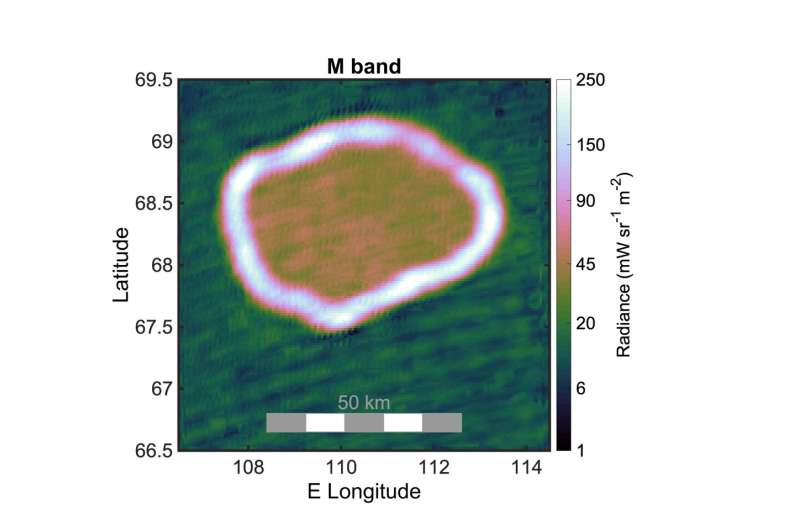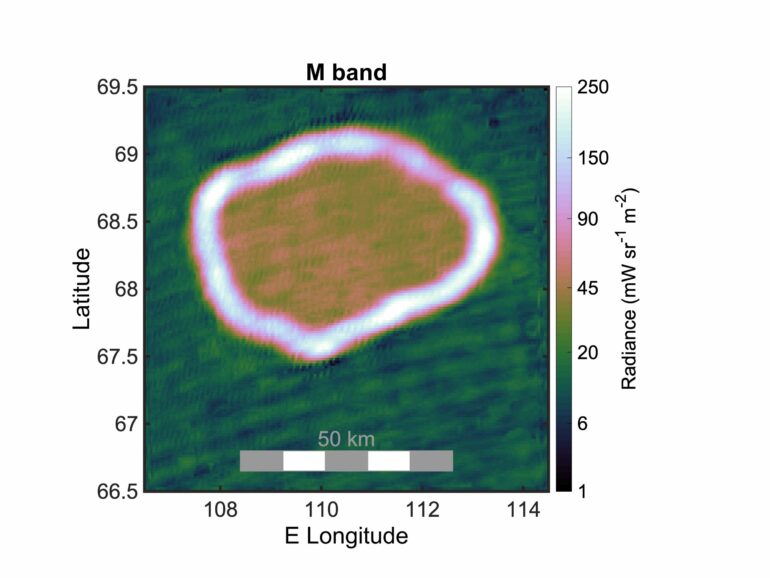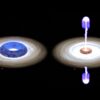New findings from NASA’s Juno probe provide a fuller picture of how widespread the lava lakes are on Jupiter’s moon Io and include first-time insights into the volcanic processes at work there. These results come courtesy of Juno’s Jovian Infrared Auroral Mapper (JIRAM) instrument, contributed by the Italian Space Agency, which “sees” in infrared light. Researchers have published a paper on Juno’s most recent volcanic discoveries in Communications Earth and Environment.
Io has intrigued astronomers since 1610, when Galileo Galilei first discovered the Jovian moon, which is slightly larger than Earth. Some 369 years later, NASA’s Voyager 1 spacecraft captured a volcanic eruption on the moon. Subsequent missions to Jupiter, with more Io flybys, discovered additional plumes—along with lava lakes. Scientists now believe Io, which is stretched and squeezed like an accordion by neighboring moons and massive Jupiter itself, is the most volcanically active world in the solar system. But while there are many theories on the types of volcanic eruptions across the surface of the moon, little supporting data exists.
In both May and October 2023, Juno flew by Io, coming within about 21,700 miles (35,000 kilometers) and 8,100 miles (13,000 kilometers), respectively. Among Juno’s instruments getting a good look at the beguiling moon was JIRAM.
Designed to capture the infrared light (which is not visible to the human eye) emerging from deep inside Jupiter, JIRAM probes the weather layer down to 30 to 45 miles (50 to 70 kilometers) below the gas giant’s cloud tops. But during Juno’s extended mission, the mission team also used the instrument to study the moons Io, Europa, Ganymede, and Callisto. The JIRAM Io imagery showed the presence of bright rings surrounding the floors of numerous hot spots.
“The high spatial resolution of JIRAM’s infrared images, combined with the favorable position of Juno during the flybys, revealed that the whole surface of Io is covered by lava lakes contained in caldera-like features,” said Alessandro Mura, a Juno co-investigator from the National Institute for Astrophysics in Rome. “In the region of Io’s surface in which we have the most complete data, we estimate about 3% of it is covered by one of these molten lava lakes.” (A caldera is a large depression formed when a volcano erupts and collapses.)

Infrared data collected Oct. 15, 2023, by the JIRAM instrument aboard NASA’s Juno shows Chors Patera, a lava lake on Jupiter’s moon Io. The team believes the lake is largely covered by a thick, molten crust, with a hot ring around the edges where lava from Io’s interior is directly exposed to space. © NASA/JPL-Caltech/SwRI/ASI/INAF/JIRAM/MSSS
Fire-breathing lakes
JIRAM’s Io flyby data not only highlights the moon’s abundant lava reserves, but also provides a glimpse of what may be going on below the surface. Infrared images of several Io lava lakes show a thin circle of lava at the border, between the central crust that covers most of the lava lake and the lake’s walls. Recycling of melt is implied by the lack of lava flows on and beyond the rim of the lake, indicating that there is a balance between melt that has erupted into the lava lakes and melt that is circulated back into the subsurface system.
“We now have an idea of what is the most frequent type of volcanism on Io: enormous lakes of lava where magma goes up and down,” said Mura. “The lava crust is forced to break against the walls of the lake, forming the typical lava ring seen in Hawaiian lava lakes. The walls are likely hundreds of meters high, which explains why magma is generally not observed spilling out of the paterae”—bowl-shaped features created by volcanism—”and moving across the moon’s surface.”
JIRAM data suggests that most of the surface of these Io hot spots is composed of a rocky crust that moves up and down cyclically as one contiguous surface due to the central upwelling of magma. In this hypothesis, because the crust touches the lake’s walls, friction keeps it from sliding, causing it to deform and eventually break, exposing lava just below the surface.
An alternative hypothesis remains in play: Magma is welling up in the middle of the lake, spreading out and forming a crust that sinks along the rim of the lake, exposing lava.
“We are just starting to wade into the JIRAM results from the close flybys of Io in December 2023 and February 2024,” said Scott Bolton, principal investigator for Juno at the Southwest Research Institute in San Antonio. “The observations show fascinating new information on Io’s volcanic processes. Combining these new results with Juno’s longer-term campaign to monitor and map the volcanoes on Io’s never-before-seen north and south poles, JIRAM is turning out to be one of the most valuable tools to learn how this tortured world works.”
Juno executed its 62nd flyby of Jupiter—which included an Io flyby at an altitude of about 18,175 miles (29,250 kilometers)—on June 13. The 63rd flyby of the gas giant is scheduled for July 16.
More information:
Alessandro Mura et al, Hot rings on Io observed by Juno/JIRAM, Communications Earth & Environment (2024). DOI: 10.1038/s43247-024-01486-5
Citation:
NASA’s Juno probe gets a close-up look at lava lakes on Jupiter’s moon Io (2024, June 26)



